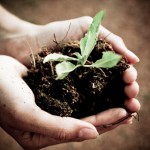How to Grow a Wildflower Garden

Most wildflower gardens are planted in borders and beds, along tree lines and roadsides, or in vacant lots. Some people plant wildflowers along their property lines as well. Before starting your wildflower garden, you should take into account the native plants with which may already be located on your property. Wildflowers are extremely adaptable and will generally grow in almost any landscape; however, if you are somewhat unfamiliar with growing wildflowers, it is often a good idea to study your surroundings in order to get a sense of the particular species which thrive in your location.
Woodland gardens are generally composed of flowering plants, grasses, shrubs, and trees. When designing a woodland garden, include layers of plants as they would be found in their natural setting. You can easily create a woodland wildflower garden by planting smaller trees, shrubs, hostas, and ferns along with your desired wildflowers. Many woodland gardens actually thrive in partially shaded areas. If your space is limited, consider planting wildflowers such as mountain anemone, bleeding heart, wild ginger, or hepatica underneath a large shade tree in your yard.
In a meadow garden, wildflowers bloom abundantly throughout the season providing the site with brilliant colors and fragrances. Most meadows contain both grasses and wildflowers. Commonly found wildflowers may include the following: Black-eyed Susans, butterfly weed, lilies, asters, coneflowers, liatris, blanket flowers, and joe-pye weed. Prairie wildflower gardens tend to mix vivid colors with various green and gold shades of prairie grasses. A natural prairie is nothing more than open grassland. Throughout the growing season, wildflowers continuously bloom while grasses provide an abundance of foliage. You can easily convert a treeless area of lawn into a prairie by planting an array of grasses such as prairie dropseed, switch grass, or Indian grass with wildflowers such as prairie clover, goldenrod, bluebells, butterfly weed, and prairie onion.
Another way to grow wildflowers is in containers. There are a wide variety of containers available to choose from. The only factor to consider when growing wildflowers by this method is drainage. Nearly any type of container will work provided it enables adequate drainage; otherwise, the plants will dry out and die. Some good choices to consider for container growing are sweet alyssum, baby’s breath, coreopsis, poppies, purple coneflowers, and Black-eyed Susans.
Wildflowers spread naturally and are normally more trouble-free and easier to maintain than other garden flowers. When designing your wildflower garden, consider using plants that bloom at various intervals. This will create a longer flowering season. Mix a number of different heights, shapes, and textures to give your wildflower garden depth. Include plants with attractive and colorful foliage, such as ferns and ornamental grasses, to keep your garden looking charming during off seasons as well.
No matter when or where you plant, the site preparation is about the same. Wildflowers look best in a natural site receiving plenty of sunlight. Since most wildflowers are sown rather than planted, you should become familiar with the varieties you wish to establish as some of these may not develop if too much soil is applied. Generally, the chosen location is freed of any debris beforehand. Gently rake the surface, spread the seed, and water. Nature takes care of the rest, which can take some time, so be patient. Once established, you will find it well worth the wait.
Once established, you can not only sit back and enjoy your wildflowers but utilize the garden as a pleasant retreat. If you want to include birds, butterflies, and other friendly creatures into the garden, consider the addition of wildlife habitats, such as birdhouses, and water features, such as small ponds. Other features, such as periodically placed stones, can add interest; while trees and shrubs can be used for food and shelter. Wildflowers offer endless displays of color, provide a comforting place to relax, and they are easy to maintain. Incorporate a wildflower garden within your landscape and take a walk on the wild side.



